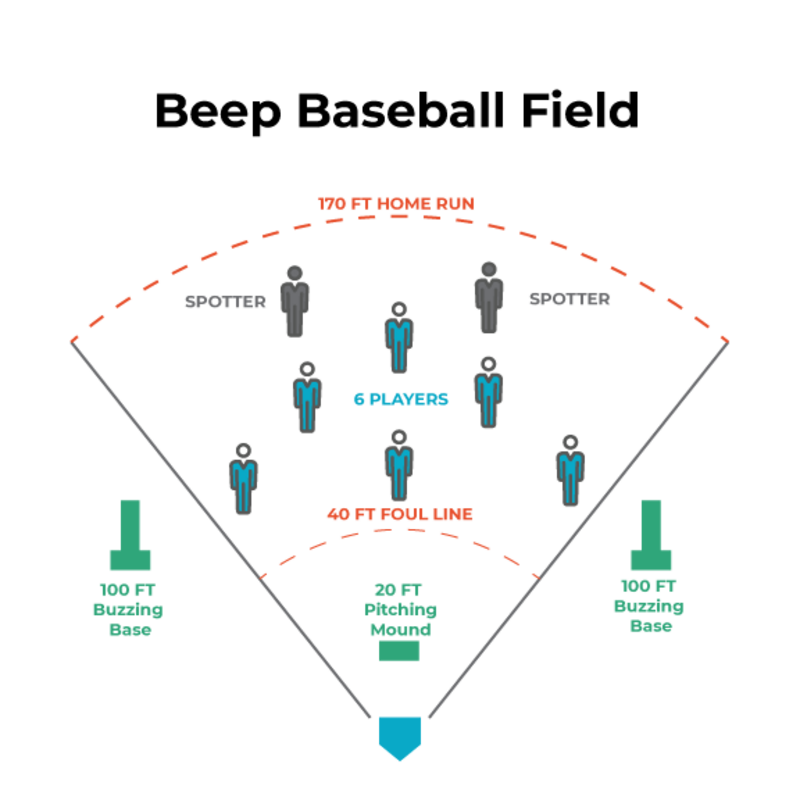
With Major League Baseball in full swing this month, those warm summer days are not far away. What better way to enjoy the summer than with some good old baseball? In 1976 the National Beep Baseball Association (NBBA) was established to allows adults who are Blind or low vision to have an opportunity to play America’s favorite pastime. Beep baseball is a competitive way for athletes who are Blind or have low vision to challenge themselves in a physically demanding way. Each baseball projects a ‘beep’ three times per second. Today, there are thirty-one co-ed teams that compete each year in local, state, and regional tournaments. Colorado has their own team based out of Denver called the Colorado Storm, who finished third in the 2017 World Series!
The first tournament for the 2019 season kicks off May 24 at the Glen Hopkins Invitational in Bryan, Texas. The 2019 World Series event is set to kick off July 28 in Tulsa, Oklahoma.
The Equipment
Beep baseballs were developed by the Denver Beep Ball group, located in Denver, Colorado, and is a volunteer project. The ball is a modified, oversized softball with a small speaker built inside. It emits three beeps every second. The bases look like something from a football field. They are blue, about five feet tall, and constructed with a foam interior. The bases have built in electronics that will buzz continuously when switched on. They are each placed one hundred feet from home plate in similar position to first and third base in regular baseball. Each player is also equipped with a specialized blindfold and NBBA patch.
Beep Ball Rules
The athletes use a combination of strength, skill and auditory senses to focus on a beeping ball and buzzing bases. A game lasts six innings, unless there is a tie. The rules of Beep baseball are similar to the original game with the exception that the pitcher throws to his own teammates and there is no second base. First and third bases are five-foot-high foam cylinders. Each base positioned one hundred feet down the respective baseline and ten feet outside the foul lines helps prevent the runner colliding with the fielder. A base operator is responsible for activating each base. Upon a successful hit, the base operator will switch on one of the bases. The runner then must identify which base is buzzing and run to it before the ball is fielded by a defensive player. There is no running from one base to another. If the umpire calls the runner safe it will count as a run. Therefore, there are three possible outcomes when it comes to offense. The first, a hit ball and the defense gets to the ball before the runner touches the base. The second, a hit ball and the runner touches the base first and a run counts, and the last one is strike out at home plate. Each batter is given four strikes and one pass ball.
Each team uses a sighted pitcher and catcher. The pitcher pitches to their own team and their goal is to allow the best opportunity for their hitter to hit the ball in play. Under the official rules the pitcher must clearly verbalize two words before pitching to alert both the defense and the batter. The first word is “ready” and the second is either “ball” or “pitch.” Any ball the travels past the forty feet mark is considered fair and any ball that travels past the one hundred- and seventy-feet mark is considered a homerun, as long as the batter makes it to the buzzing base within thirty seconds. A homerun is worth two runs. The pitcher is not allowed to field or bat. If the ball touches the pitcher it is ruled a “no pitch.”
The defense side can be one of the more challenging aspects of the game. Each team has six defensive players on the field at a time. There is no set defensive placement for each player. Typically, each team will use a numbering system to reflect where the ball is hit to. The numbers are one through six and in the shape of a pie emanating from home plate. These numbers are important for a team because each team has one or two sighted spotters positioned in the outfield. When a ball is hit the spotter will shout the number indicating the general direction the ball is traveling. Outs are earned when the fielder fields the ball before the batter reaches the base. If the fielder catches the ball in the air, it counts for three outs and finishes the inning.
Beep baseball continues to evolve with improved training and coaching methods every year. Play ball!